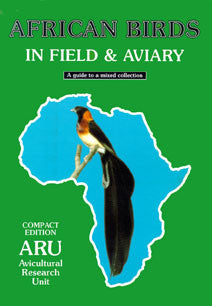





African Birds in Field & Aviary: a guide to a mixed collection
By: Avicultural Research Unit
ISBN: 0-620-21438-4
Binding: Trade Paper
Size: 11" X 8.5"
Pages: 262
Photos: 47
Illustrations: 200
Publication Date: 1997
PR Highlights: Guide to a mixed collection of African aviculture
PHOTO Highlights: 8 page full-color photo section.
Table of Contents
Sample Chapter
Description: A practical guide to the wonderful hobby of birdkeeping. Concentration is on African species of Aviculture. The Purpose of this book is to provide a practical guide to the wonderful hobby of birdkeeping. It provides a coordinated synthesis of up-to-date information researched from many sources, in a form which has seldom been published before as an avicultural work, but with all the wealth of information here presented, it cannot be complete, for despite the intensive field research and captive observations undertaken in Africa, many species are still inadequately known.
Book Reviews:
Guy Kirwan
African Birding Club Bulletin, Sept 1998
Whilst the short preface to this book announces that is has been produced to 'provide a practical guide to the wonderful hobby of birdkeeping', in practice it also provides a useful resource for field ornithologists seeking data on African birds. The text was formerly published in two separate volumes (in 1989 and 1996) but has been revised and updated for this new and more comprehensive edition. The species accounts cover 279 species within the following family groupings: Phasianidae, Turnicidae, Pteroclididae, Columbidae, Psittacidae, Ploceidae, Estrildidae, Fringillidae and Emberizidae. As a significant number of the species included here have not yet been covered by the relevant volume of The Birds of Africa, it should be automatically apparent that this volume will provide a useful compendium of published and unpublished information, as data have been extracted from both existing sources and nest record cards. For each species, the following data are supplied: 'Description' including subspecies information, 'Voice', 'Habitat', 'Distribution' which again includes information to subspecies level, 'Feeding', 'Breeding', and 'Aviculture'. Alternative English names and overall body length data are also incorporated. Particularly valuable is that data from the avicultural records are sourced to the number of available datasets for each fact. The book is completed by a series of sections designed to guide the uninitiated through the process of starting and running a successful aviary; distribution maps for all species covered in the text; references; and an index. Despite its image as being a work for non-field ornithologists and cagebird keepers, this book is, in fact, also a valuable research tool for those solely interested in wild birds.